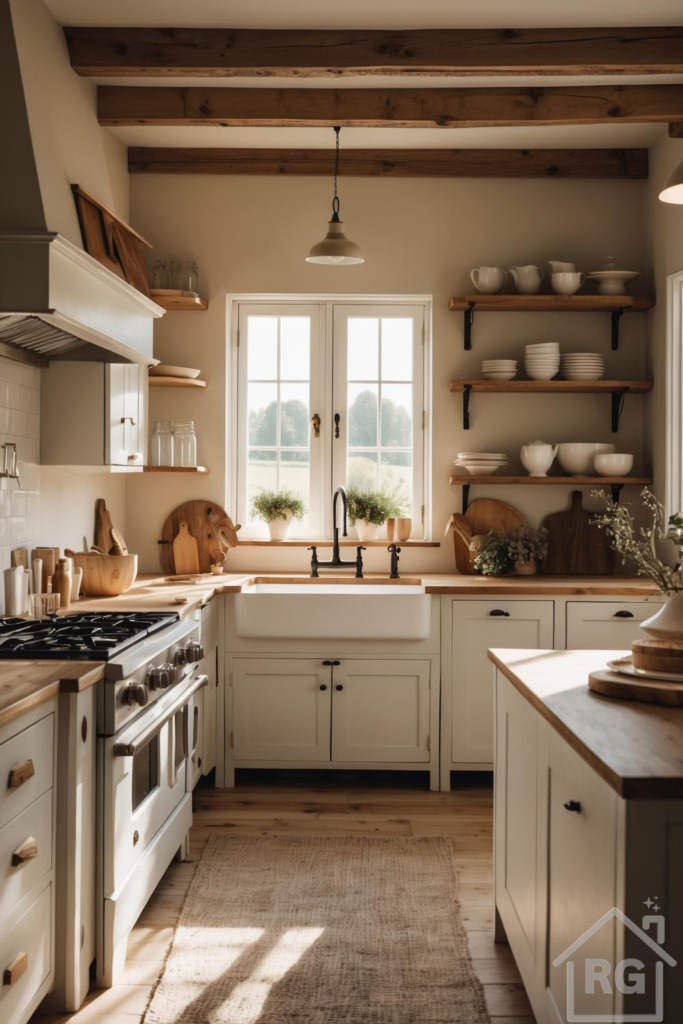
The farmhouse kitchen has long been celebrated as the heart of the home, a place where comfort, functionality, and timeless style converge. It evokes a sense of warmth, history, and connection to nature, making it a beloved aesthetic for many homeowners. Imagine a space bathed in natural light, where the scent of freshly baked bread mingles with the earthy aroma of wood, and every element feels thoughtfully chosen to create a welcoming atmosphere. This guide will delve into the essential elements and design principles that define the quintessential farmhouse kitchen, helping you achieve a look that is both beautiful and deeply personal.
At its core, the farmhouse kitchen is about embracing natural materials, a soft, inviting color palette, and a blend of rustic and refined elements. It’s a style that prioritizes practicality without sacrificing charm, creating a space that feels lived-in and loved.
The Harmonious Color Palette
The foundation of a captivating farmhouse kitchen lies in its serene and earthy color scheme. Unlike stark modern designs, the farmhouse palette leans into soft, muted tones that feel comforting and organic. The dominant colors often include:
- Creamy Whites and Off-Whites: These form the backbone of the design, appearing on cabinetry, walls, and even the iconic farmhouse sink. They provide a clean, bright backdrop that allows other natural elements to shine, reflecting light beautifully and making the space feel expansive and airy.
- Soft Beiges and Greiges: These warm neutrals on walls or backsplashes add depth and a subtle hint of color without overpowering the room. They complement the whites and woods, creating a cohesive and inviting environment.
- Rich Wood Tones: From the deep, grounding browns of exposed ceiling beams to the lighter, honeyed hues of butcher block countertops and wide-plank flooring, wood is indispensable. These natural tones bring warmth, texture, and an undeniable sense of authenticity to the space.
- Subtle Greens: Often introduced through potted herbs, leafy plants, or even a muted sage green accent, these touches connect the interior with the natural world outside, adding a refreshing pop of life.
- Deep Accents: Matte black or oil-rubbed bronze hardware, faucets, and light fixtures provide a striking contrast against the lighter palette, grounding the design and adding a touch of modern sophistication without detracting from the rustic feel.
Textures That Tell a Story
Beyond color, the farmhouse kitchen thrives on a rich interplay of textures. These tactile elements add depth, character, and a sense of history to the space, inviting touch and creating visual interest. Consider incorporating:
- Natural Wood: This is perhaps the most defining texture. Think rough-hewn exposed beams that traverse the ceiling, telling tales of craftsmanship and heritage. Butcher block countertops, with their warm grain and ability to show the marks of use, add a lived-in charm. Wide-plank hardwood floors provide a sturdy, grounding base, while open wooden shelves display a curated collection of dishes and decor.
- Smooth Ceramic and Porcelain: The classic farmhouse sink, with its deep basin and smooth, glossy finish, is a central feature. Subway tile backsplashes offer a clean, timeless look, while ceramic dinnerware displayed on open shelves adds a touch of simple elegance.
- Woven Fibers: A jute or sisal runner rug underfoot not only adds a layer of softness and warmth but also introduces an organic, earthy texture that complements the natural wood elements. These natural fibers contribute to the cozy, unpretentious feel.
- Cool Metals: Stainless steel appliances, while modern, can blend seamlessly with the farmhouse aesthetic, especially when paired with matte black or bronze hardware. Industrial-style pendant lights or sturdy shelf brackets introduce a subtle industrial edge that enhances the rustic appeal.
- Glass: Clear glass jars filled with pantry staples or fresh flowers add a touch of transparency and sparkle, reflecting light and contributing to the bright, airy feel.
Key Elements and Furnishings
Certain elements are almost synonymous with the farmhouse kitchen, each contributing to its distinctive character:
- The Farmhouse Sink: Deep, wide, and typically made of white ceramic or fireclay, this sink is not just a functional item but a focal point. Its generous size is perfect for large pots and pans, embodying the practical spirit of farmhouse living. Paired with a classic bridge faucet or a sleek matte black one, it becomes a statement piece.
- Shaker-Style Cabinetry: With their clean lines and simple recessed panel doors, Shaker cabinets are a perfect fit for the farmhouse aesthetic. They offer a timeless look that can be painted in creamy whites, soft grays, or even natural wood tones.
- Open Shelving: A hallmark of farmhouse design, open shelves provide an opportunity to display beautiful ceramic dishes, glassware, cookbooks, and decorative items. They contribute to an airy feel and make everyday items easily accessible.
- Butcher Block Countertops: These warm, inviting surfaces are not only beautiful but also highly functional. They can be sanded and re-oiled, developing a rich patina over time that adds to the kitchen’s character.
- Classic Range and Hood: While modern appliances are necessary, choosing a range with a classic, perhaps even vintage-inspired, design can enhance the farmhouse feel. A custom-built range hood, often clad in wood or painted to match the cabinetry, helps integrate this essential appliance seamlessly.
- Pendant Lighting: Simple, industrial-style pendant lights, often with metal shades in white, black, or brushed nickel, provide task lighting over the sink or island and contribute to the overall aesthetic.
- Natural Light: Large windows, often with multiple panes, are crucial. They flood the space with sunlight, connecting the interior with the outdoors and enhancing the bright, cheerful atmosphere. Potted herbs on the windowsill further blur the lines between inside and out.
Design Principles for a Cohesive Look
Achieving a truly harmonious farmhouse kitchen goes beyond simply selecting the right elements; it involves applying thoughtful design principles:
- Balance of Old and New: The beauty of farmhouse style lies in its ability to blend rustic, vintage-inspired pieces with modern conveniences. This creates a space that feels both timeless and current. For instance, pairing antique wooden cutting boards with sleek, contemporary appliances.
- Functionality and Flow: A farmhouse kitchen, above all, must be practical. Consider the workflow between the sink, stove, and refrigerator. Ensure ample counter space for prep and easy access to frequently used items. The layout should feel intuitive and comfortable for cooking and gathering.
- Layering Textures and Materials: As discussed, the interplay of different textures is vital. Don’t be afraid to mix smooth ceramics with rough wood, soft woven rugs with hard metal fixtures. This layering adds depth, warmth, and visual interest, preventing the space from feeling flat.
- Embracing Imperfection: Unlike highly polished, pristine styles, farmhouse design celebrates the beauty of imperfection. A slightly worn wooden stool, a chipped ceramic bowl, or the natural grain of wood all contribute to the authentic, lived-in feel.
- Personalization: Your kitchen should reflect your personality and lifestyle. Incorporate items that have meaning to you, whether it’s a collection of vintage cookbooks, a family heirloom, or artwork that speaks to your taste. These personal touches make the space uniquely yours.
Tips for Creating Your Own Farmhouse Kitchen
Ready to transform your kitchen into a farmhouse haven? Here are some actionable tips:
- Start with a Mood Board: Gather images of farmhouse kitchens that inspire you. Pay attention to common themes in color, texture, and specific elements. This will help you define your vision and ensure consistency.
- Prioritize Natural Light: If possible, maximize natural light with large windows or by keeping window treatments minimal. Natural light enhances the warm, airy feel and highlights the natural materials.
- Invest in Key Pieces: While you don’t need to break the bank, consider investing in a quality farmhouse sink, durable countertops, and well-built cabinetry. These foundational elements will define the space.
- Curate Your Open Shelves: Don’t just fill them. Think about what you want to display. Group similar items, use varying heights, and incorporate a few decorative pieces like small plants or vintage finds.
- Incorporate Greenery: Potted herbs like rosemary or basil on the windowsill, a small fern on a shelf, or a vase of fresh wildflowers instantly bring life and freshness into the space.
- Mix and Match Seating: If you have an island or dining area, consider mixing different chair styles or incorporating a bench for a more relaxed, eclectic farmhouse feel.
- Don’t Forget the Details: The small touches make a big difference. Think about your choice of cabinet hardware, the type of faucet, and even the dish towels you use. These elements contribute to the overall aesthetic.
- Consider Sustainability: Many natural materials used in farmhouse design, like wood and ceramic, are durable and sustainable choices. Opt for reclaimed wood or locally sourced materials where possible.
The farmhouse kitchen is more than just a design trend; it’s a lifestyle choice that celebrates comfort, community, and the beauty of simplicity. By focusing on natural materials, a warm color palette, and a thoughtful blend of rustic and refined elements, you can create a kitchen that not only looks stunning but also feels like a true sanctuary — a place where memories are made and cherished for years to come.
